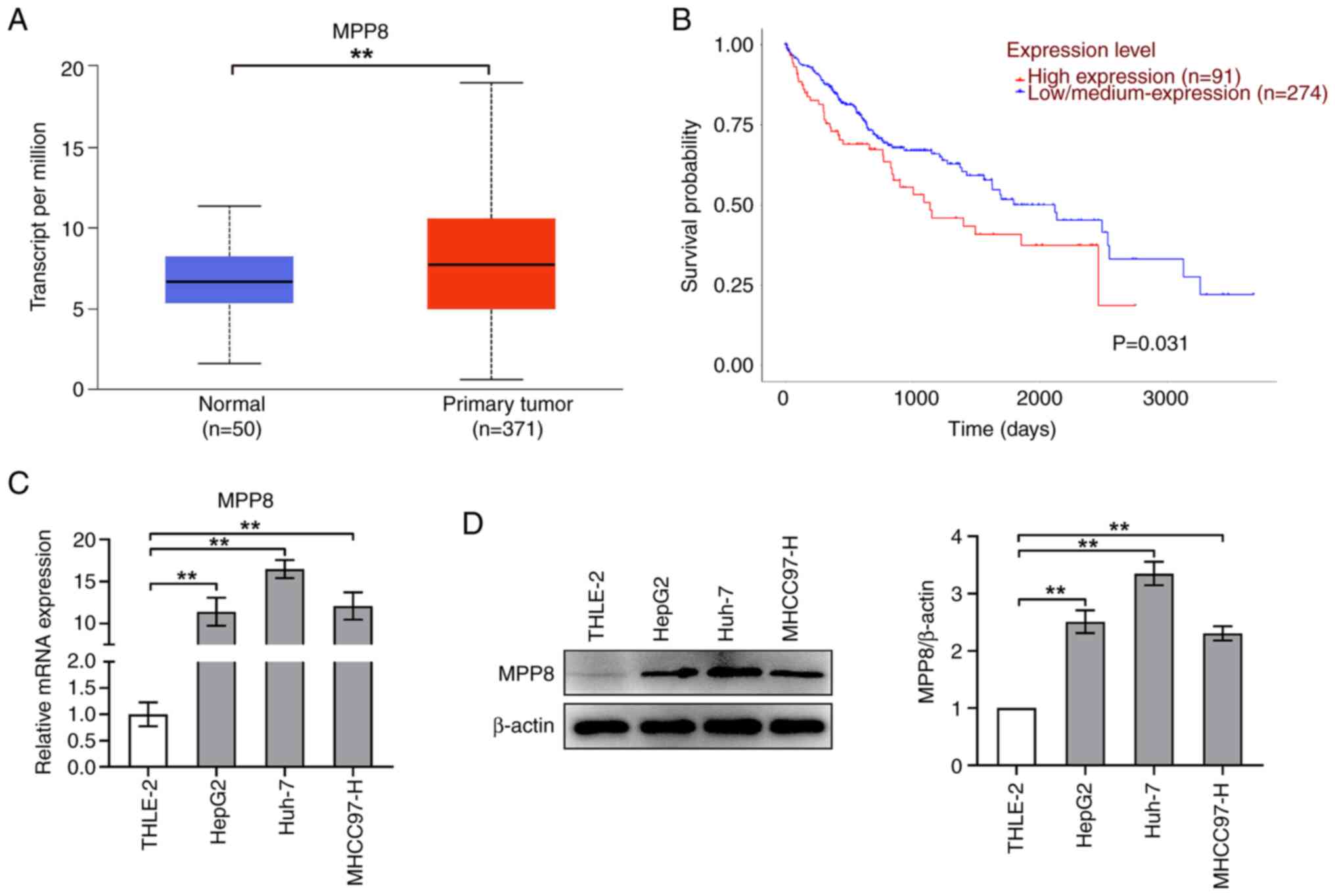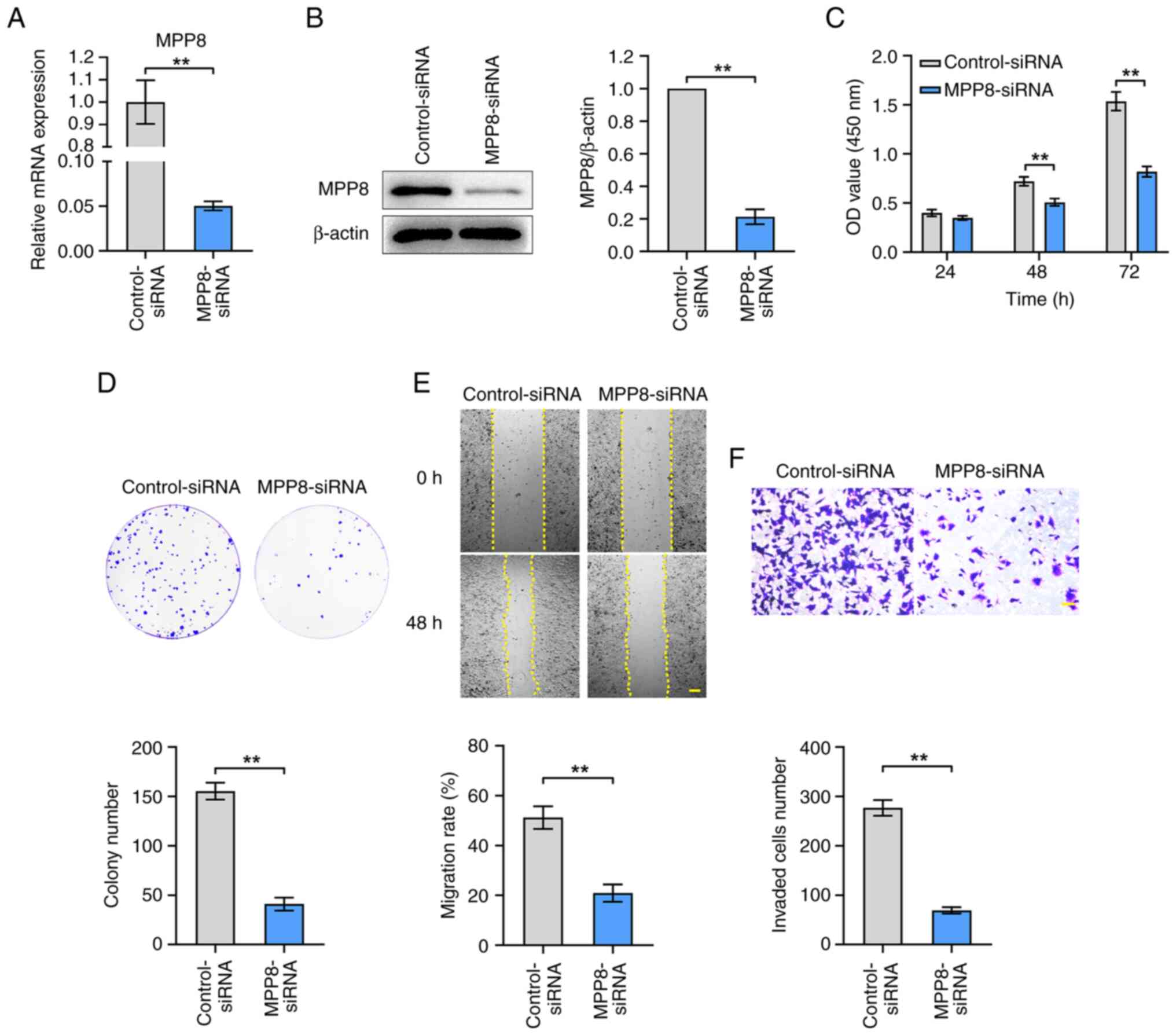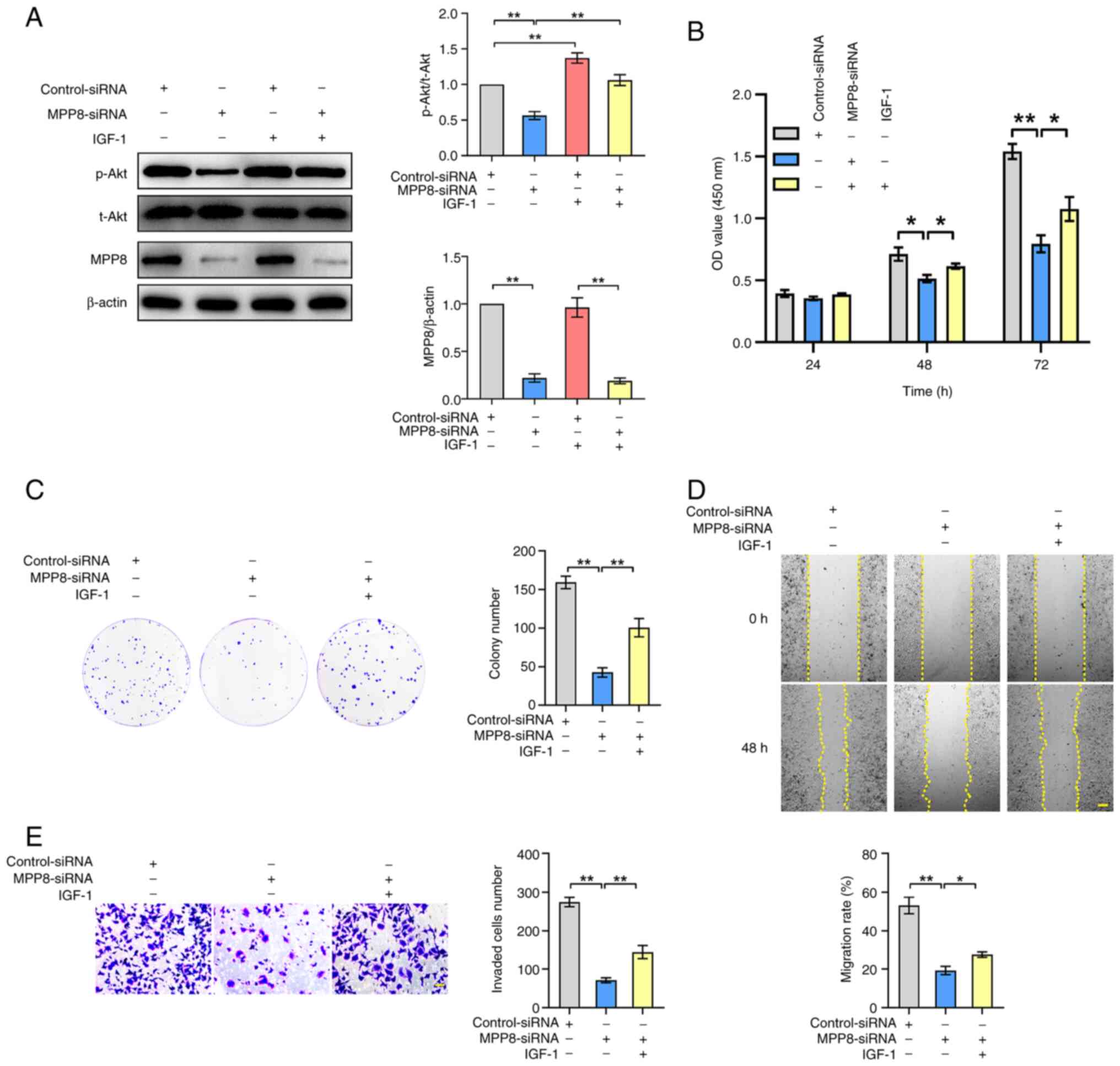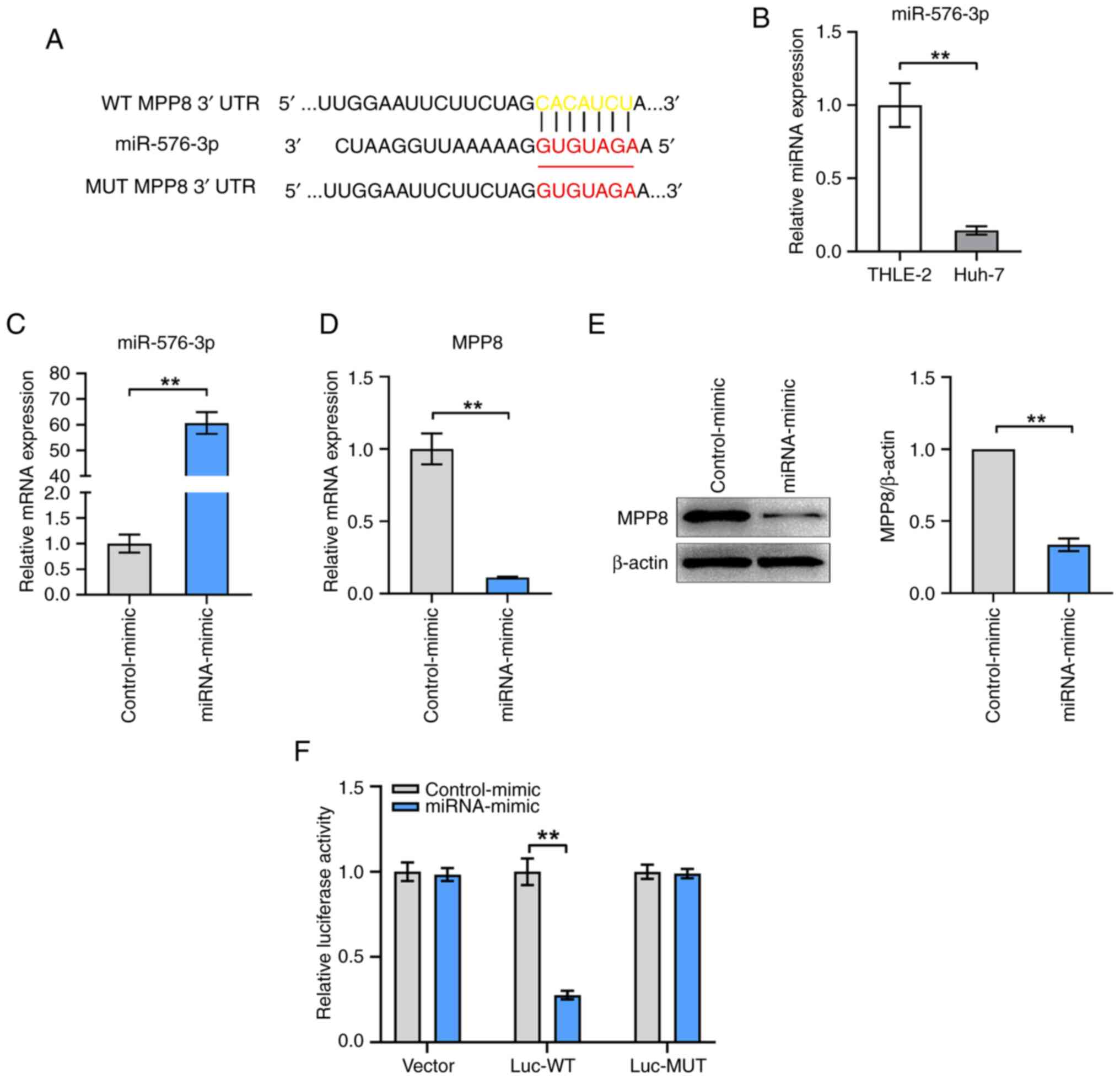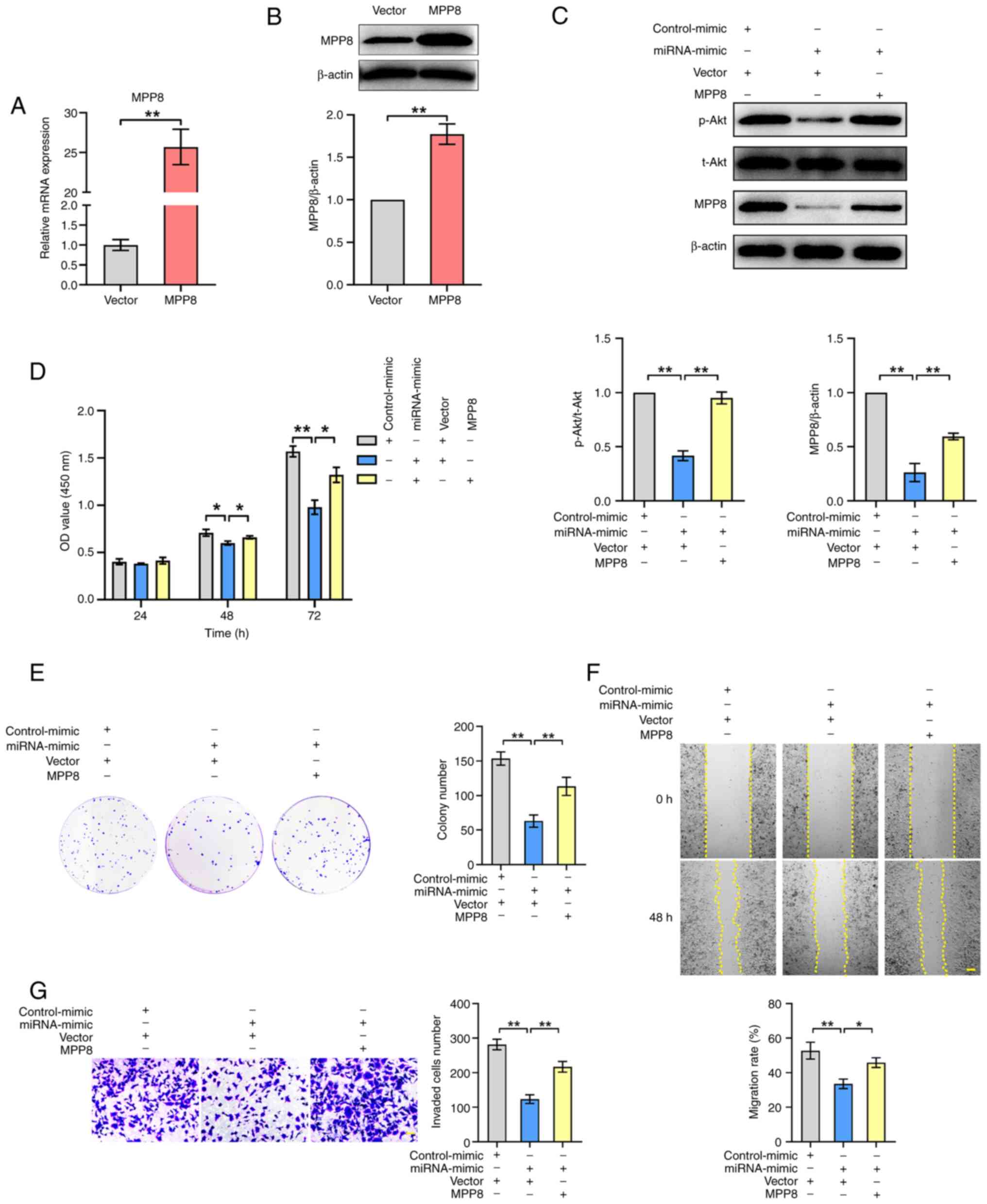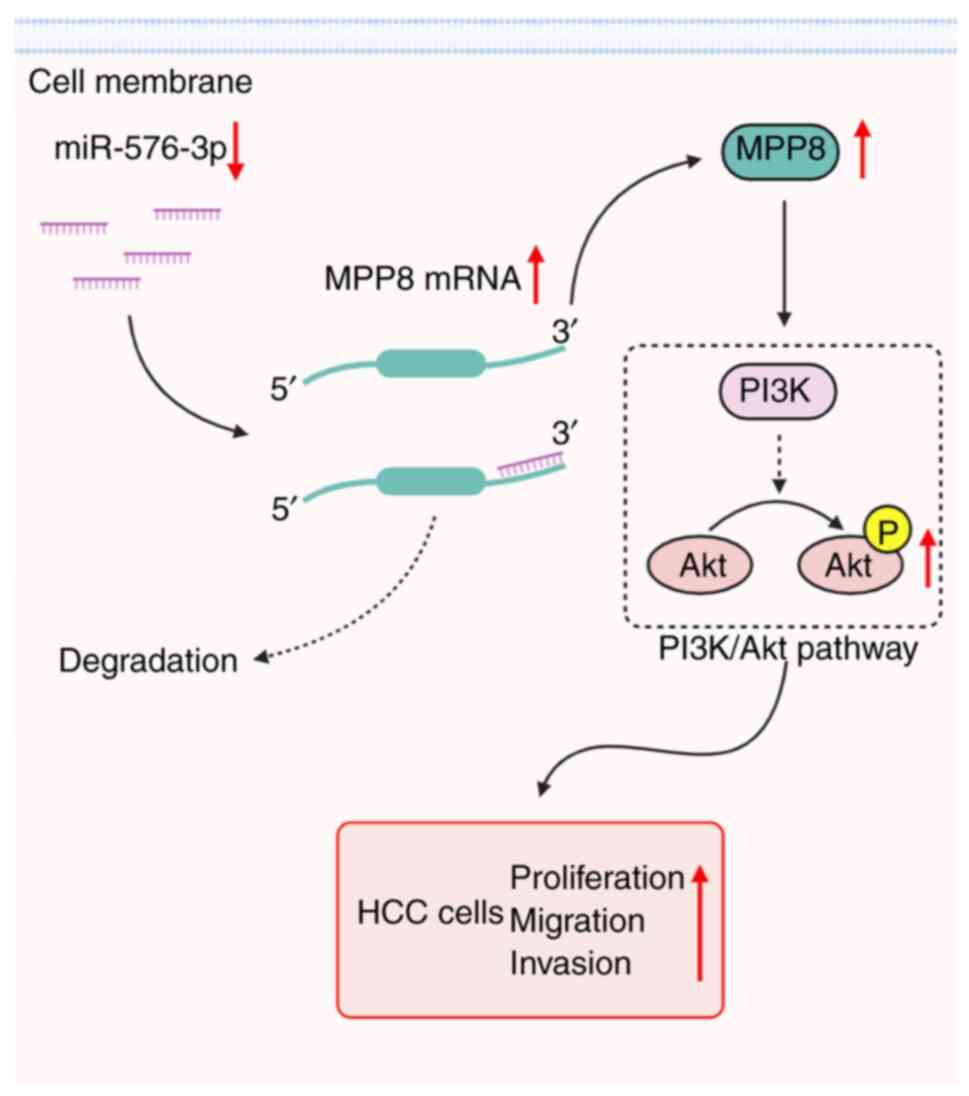miR‑576‑3p/M‑phase phosphoprotein 8 axis regulates the malignant progression of hepatocellular carcinoma cells via the PI3K/Akt signaling pathway
- Authors:
- Published online on: May 16, 2024 https://doi.org/10.3892/ol.2024.14460
- Article Number: 327
-
Copyright: © Zhang et al. This is an open access article distributed under the terms of Creative Commons Attribution License.
Abstract
Introduction
Hepatocellular carcinoma (HCC) is a common type of liver cancer, which is a growing global public health problem (1). The majority of patients with HCC are diagnosed at an advanced stage with a <12.5% 5-year survival (2,3). Currently, surgery is the cornerstone treatment of HCC; however, due to the metastasis and recurrence, the prognosis of HCC remains unsatisfactory (4). In particular, treatment options for advanced HCC are limited. The mechanisms underlying the tumorigenesis and development of HCC are still unclear, which is a key reason for the lack of effective treatments for HCC (5). Thus, it is crucial that the mechanisms and novel therapeutic targets of HCC are uncovered.
M-phase phosphoprotein 8 (MPP8), encoded by MPHOSPH8, was first identified as an M-phase phosphoprotein in 1996 (6). This protein has been found to bind methylated histone H3 lysine 9 (H3K9m3) (7), and to mediate the recruitment of the human silencing hub, a complex containing MPP8, to genomic loci rich in H3K9me3 (8). In previous years, the role of MPP8 in cancers has been gradually gaining attention (9). Previous studies have shown that MPP8 plays a cancer-promoting role in non-small cell lung cancer, gastric cancer and melanoma (10–13); however, its role in HCC remains unclear.
MicroRNAs (miRNAs) are a large class of small non-coding RNAs with a length of ~22 nucleotides (14). miRNAs can attenuate target gene expression through specifically binding to the 3′ untranslated region (3′ UTR) of the mRNA of the target gene (15). MiR-576-3p has been reported to be a tumor suppressor that plays a suppressive role in the proliferation, migration and invasion of HCC cells (16); however, the molecular mechanisms have yet to be elucidated, and at present there have been no studies on the association between miR-576-3p and MPP8.
The PI3K/Akt signaling pathway plays a crucial role in multiple malignant phenotypes of HCC cells including proliferation, migration and invasion (17). Akt, the key node of this signaling pathway, becomes activated by phosphorylation and performs functions by regulating a series of downstream effectors. Activation of the PI3K/Akt pathway can be determined by assessing the level of Akt phosphorylation (18). At present, the relationship between MPP8 and the PI3K/Akt signaling pathway in HCC remains unclear.
In the present study, the role of MPP8 was evaluated by modulating malignant phenotypes of HCC cells. Furthermore, the upstream and downstream regulatory mechanisms of MPP8 were investigated.
Materials and methods
Bioinformatics analysis
MPP8 expression analysis and related survival analysis was performed using The University of Alabama at Birmingham Cancer data analysis Portal (UALCAN; http://ualcan.path.uab.edu/) (19) based on the data from The Cancer Genome Atlas (TCGA; ID: TCGA-LIHC; http://portal.gdc.cancer.gov/projects/TCGA-LIHC). Significance cut-off level was set at P<0.05. TargetScanHuman (version 7.2; http://www.targetscan.org/vert_72/) (20) and miRDB (http://mirdb.org/mirdb) (21) were used to predict the potential miRNAs that target the 3′ UTR of MPP8 mRNA and specific binding sites.
Cell culture
The normal liver cell line THLE-2 was purchased from American Type Culture Collection. The liver cancer cell lines Hepg2 and Huh7 were purchased from The Cell Bank of Type Culture Collection of The Chinese Academy of Sciences. The liver cancer cell line MHCC97-H was purchased from Shanghai Zhong Qiao Xin Zhou Biotechnology Co., Ltd. The cells were cultured in DMEM containing 10% fetal bovine serum (FBS) and 1% penicillin/streptomycin at 37°C with 5% CO2. All cell culture reagents were purchased from Gibco (Thermo Fisher Scientific, Inc.).
Reverse transcription-quantitative PCR (RT-qPCR)
RT-qPCR was performed to detect the levels of mRNA and miRNA. For mRNA detection, total RNA of each sample (n=3) was extracted using TRIzol® reagent (Invitrogen; Thermo Fisher Scientific, Inc.). cDNA for detecting MPP8 (MPHOSPH8) and β-actin (ACTB) were synthesized by the reverse transcription method with a 1st Strand cDNA Synthesis SuperMix Kit (cat. no. 11141ES; Shanghai Yeasen Biotechnology Co., Ltd.). RT reaction was conducted as follows: 25°C for 5 min, 55°C for 15 min, and 85°C for 5 min. qPCR for mRNA detection was performed with a qPCR SYBR Green Master Mix (cat. no. 11201ES; Shanghai Yeasen Biotechnology Co., Ltd.). qPCR was performed as follows: 95°C for 5 min, 40 cycles of 95°C for 10 sec, 60°C for 20 sec, and 72°C for 20 sec. For miRNA detection, total miRNA of each sample was extracted using a MiPure Cell/Tissue miRNA Kit (cat. no. RC201; Vazyme Biotech Co., Ltd.). cDNA for detecting miR-576-3p and U6 were synthesized using a miRNA 1st Strand cDNA Synthesis Kit (by stem-loop; cat. no. MR101; Vazyme Biotech Co., Ltd.). The RT reaction was conducted as follows: 25°C for 5 min, 55°C for 15 min, and 85°C for 5 min. qPCR for miRNA detection was performed with a miRNA Universal SYBR qPCR Master Mix (cat. no. MQ101; Vazyme Biotech Co., Ltd.). The qPCR was performed as follows: 95°C for 5 min, 40 cycles of 95°C for 10 sec and 60°C for 30 sec. MPHOSPH8 expression was normalized to ACTB, and miR-576-3p expression was normalized to U6 (22). The 2−∆∆Cq method was used to calculate the relative RNA expression levels (23). The primers used in qPCR are listed in Table I and triplicates of each sample were run.
Antibodies and drugs
Primary antibodies for western botting were as follows: Anti-MPP8 (1:10,000; cat. no. 16796–1-AP; Proteintech Group, Inc.), anti-β-actin (1:10,000; cat. no. 60008-1-Ig; Proteintech Group, Inc.), anti-phospho-pan-Akt (1:500; cat. no. AF0016; Affinity Biosciences, Ltd.) and anti-pan-Akt (1:500; cat. no. AF6261; Affinity Biosciences, Ltd.). Secondary antibodies for western blotting (1:10,000; goat anti-mouse, cat. no. SA00001-1; goat anti-rabbit, cat. no. SA00001-2) were purchased from Proteintech Group, Inc. Recombinant human insulin-like growth factor-1 (IGF-1) protein (cat. no. 291-G1; R&D Systems, Inc.), the agonist of the PI3K/Akt signaling pathway used for rescue experiments, was dissolved in culture medium and used at a concentration of 100 ng/ml.
Western blotting
Western blotting was used to detect protein levels. First, total protein of each sample (n=3) was extracted using RIPA lysis buffer (CST Biological Reagents Co., Ltd.). Protein concentration determination was performed using a BCA Protein Assay kit. The protein samples (20 µg of total protein per lane) were separated on 10% SDS-PAGE gels (Shanghai Yeasen Biotechnology Co., Ltd.), and then electro-transferred onto 0.45 µm PVDF membranes (MilliporeSigma). After blocking with 5% bovine serum albumin (MilliporeSigma) in Tris-buffered saline containing 0.05% Tween-20 (Beijing Solarbio Science & Technology Co., Ltd.) for 1 h at room temperature, incubation with primary antibodies overnight at 4°C, and incubation with corresponding secondary antibodies for 1 h at room temperature, protein chemiluminescence was detected using an ECL kit (Tanon Science and Technology Co., Ltd.). The gray value of the band was quantified using ImageJ (version 1.51; National Institutes of Health). β-actin was used as the control.
Cell transfection
Small interfering RNAs (siRNAs) for MPP8 knockdown and scrambled siRNAs as a control were synthesized by Sangon Biotech Co., Ltd., and the sequences were as follows: MPP8-siRNA forward, CCAAAGCAGUCAGGAAGGAUAUUCA, and reverse, UGAAUAUCCUUCCUGACUGCUUUGG; control-siRNA forward, UUCUCCGAACGUGUCACGUTT, and reverse, ACGUGACACGUUCGGAGAATT. MiR-576-3p-mimic (cat. no. 4464066) for up-regulating miR-576-3p expression and corresponding control-mimic (cat. no. 4464058) were purchased from Thermo Fisher Scientific, Inc. (sequences not available). The human MPHOSPH8 gene (NM_017520.4) was cloned into pcDNA 3.1/His B (cat. no. V385-20; Thermo Fisher Scientific, Inc.) for protein overexpression, and the empty vector was used as a control. Lipofectamineâ 3000 transfection reagent (cat. no. L3000075; Thermo Fisher Scientific, Inc.) was used to transfect the siRNAs (50 nM), miRNA-mimics (50 nM) and plasmids (1 µg/ml) into HCC cells following the manufacturer's instructions. After transfection for 6 h at 37°C, culture medium was replaced with fresh medium, and cells were cultured for another 24 h.
Cell proliferation assay
The Cell Counting Kit-8 (CCK-8) assay was performed to assess cell proliferation. Liver cancer cells (n=3) were seeded at 2,500 cells/well in a 96-well culture plate. After cell attachment, the cells were processed according to experimental requirements, and timing was started. After this, at 24, 48 and 72 h timepoints, 10 µl of CCK-8 (cat. no. 40210ES; Shanghai Yeasen Biotechnology Co., Ltd.) solution was added to each well. After 2 h of incubation at 37°C, the absorbance was measured at 450 nm with a microplate reader (Thermo Fisher Scientific, Inc.). The CCK-8 assay results were expressed as optical density values, which reflect the number of viable cells.
The plate colony formation assay was used to assess cell proliferation. Liver cancer cells (n=3) were seeded at 200 cells/well in a 12-well culture plate. After incubation for 10 days, the colonies were fixed in 4% paraformaldehyde (Beijing Solarbio Science & Technology Co., Ltd.) for 20 min at room temperature, and stained with 1% Crystal Violet Ammonium Oxalate Solution (Beijing Solarbio Science & Technology Co., Ltd.) for 15 min at room temperature. Colony (>50 cells/colony) numbers were counted using ImageJ software.
Cell migration assay
The wound healing assay was used to assess cell migration (24). Liver cancer cells (n=3) were seeded at 1×106 cells/well in a 6-well culture plate in complete DMEM containing 10% FBS. After cell attachment, cells were serum-starved and a 200-µl pipette tip was used to make a scratch in each well. Images were captured at four random fields of view using a light microscope (magnification, ×40; Olympus Corporation) at 0 and 48 h timepoints. Wound area was measured using Image J software. Wound-healing assay results were presented as migration rate (%)=(initial wound area-wound area at 48 h)/initial wound area ×100.
Cell invasion assay
Transwell invasion assay was performed to assess cell invasion. Liver cancer cells (n=3) were seeded at 5×104 cells/well in the upper chambers of Transwell plates (24-well, 8-µm pore size; Labgic Technology Co., Ltd.), which were precoated with Matrigel (Corning, Inc.) at 37°C for 1 h. The upper chamber was supplied with FBS-free DMEM, and the lower chamber was supplied with DMEM containing 10% FBS. Following 24 h incubation at 37°C, non-invasive liver cancer cells remaining on the upper side of the membrane were removed using a cotton swab. After which, the invaded cells were fixed in 4% paraformaldehyde for 20 min at room temperature, and stained with 1% Crystal Violet Ammonium Oxalate Solution for 15 min at room temperature. Images were captured at four random fields of view using a light microscope (magnification, ×200). The number of invaded cells were counted using ImageJ software.
Dual-luciferase reporter gene assay
The luciferase reporter plasmids containing the predicted miR-576-3p binding site of wild-type MPP8 3′UTR (Luc-WT) or mutant MPP8 3′UTR (Luc-MUT) were constructed using pEZX-MT06 (Guangzhou iGene Biotechnology Co., Ltd.). The empty vectors, Luc-WT and Luc-MUT were co-transfected with control-mimic or miR-576-3p-mimic into liver cancer cells using the transfection agent Lipofectamine® 3000 as aforementioned. After 48 h, the results expressed as relative luciferase activity (Firefly luciferase/Renilla luciferase) were determined using a Duo-Luciferase HS Assay kit (cat. no. LF005; Guangzhou iGene Biotechnology Co., Ltd.) following the manufacturer's instructions.
Statistical analysis
All quantified data were expressed as the mean ± standard deviation. Statistical analysis was performed using GraphPad Prism statistical package (version 8.0.1; Dotmatics). Data normality was analyzed using Shapiro-Wilk test. CCK-8 assay data was analyzed by two-way ANOVA followed by post hoc Sidak's or Tukey's test. In addition, statistical differences between multiple groups were analyzed by one-way ANOVA followed by post hoc Sidak's test. Statistical differences were determined using Student's unpaired t-test for two-group comparisons. P<0.05 was considered to indicate a statistically significant difference.
Results
Expression of MPP8 in HCC
First, MPP8 expression and survival analysis were performed using the UALCAN database. As shown in Fig. 1A, the expression level of MPP8 in normal samples was significantly higher than that in primary tumor samples. The results of the survival analysis showed that patients with low/medium MPP8 expression had improved survival time than those with high MPP8 expression (Fig. 1B). Next, to verify the expression of MPP8 in cells, RT-qPCR and western blotting were performed to assess the levels of mRNA and protein, respectively. As shown in Fig. 1C, the mRNA level of MPP8 in liver cancer cell lines (HepG2, Huh-7 or MHCC97-H) was significantly higher than that in a normal liver cell line (THLE-2), which was consistent with the expression results obtained by the database analysis. Furthermore, western blotting revealed similar trends to those of the RT-qPCR (Fig. 1D). Overall, these data demonstrated that MPP8 was upregulated in liver cancer cell lines and was a risk factor for HCC. Additionally, based on the expression results, the Huh-7 cell line was chosen for subsequent experiments.
Role of MPP8 in the proliferation, migration, and invasion of HCC cells
To evaluate the role of MPP8 in regulating the malignant phenotypes of HCC cells, the effects of MPP8 knockdown on cell proliferation, migration and invasion were measured. MPP8-siRNA was used to down-regulate the expression of MPP8. As shown in Fig. 2A and B, the results of RT-qPCR and western blotting confirmed the efficacy of MPP8-siRNA in inhibiting MPP8 expression. Then related assays were performed to examine the malignant phenotypes of HCC cells. The results of the CCK-8 assay showed that the viability of HCC cells in the knockdown group was significantly lower than that in the control group at 48 and 72 h timepoints (Fig. 2C). In the plate colony formation assay, the knockdown group showed significantly lower colony numbers than the control group (Fig. 2D). Moreover, in the wound healing assay, the knockdown group showed a significantly lower migration rate than the control group (Fig. 2E). Knockdown group showed a significantly lower number of invaded cells than the control group (Fig. 2F). Overall, these results demonstrated that MPP8 played a promoting role in the proliferation, migration, and invasion of HCC cells.
Role of the PI3K/Akt signaling pathway in MPP8-mediated regulatory effects on the malignant phenotypes of HCC cells
To further investigate whether the PI3K/Akt pathway was involved in MPP8-mediated regulation of HCC cells, the level of Akt phosphorylation was detected to evaluate the activation level of this pathway, and IGF-1, an agonist of the PI3K/Akt pathway, was used for the subsequent rescue experiments. As shown in Fig. 3A, down-regulating MPP8 expression significantly inhibited the ratio of phosphorylated (p-) Akt/total (t-) Akt. Meanwhile, the results also showed that IGF-1 stimulation raised the ratio of p-Akt/t-Akt and reversed the inhibited ratio by MPP8 knockdown. These results indicated that MPP8 promoted the PI3K/Akt pathway in HCC cells, and the IGF-1 as a pathway agonist was effective. Next, related rescue experiments were carried out. The CCK-8 assay results revealed that activating the PI3K/Akt pathway significantly reversed the inhibited viability of HCC cells by MPP8 knockdown at 48 and 72 h timepoints (Fig. 3B). The results of plate colony formation assay showed that activating the pathway significantly reversed MPP8 knockdown-induced reduction in the colony number of Huh-7 cells (Fig. 3C). As for cell migration, the results of wound-healing assay revealed that activating the pathway significantly reversed the inhibited migration rate of HCC cells by MPP8 knockdown (Fig. 3D). The results of the Transwell assay showed that activating the pathway significantly reversed the decrease in invaded cells number induced by MPP8 knockdown (Fig. 3E). Overall, these data demonstrated that MPP8 promoted the proliferation, migration and invasion of HCC cells by activating the PI3K/Akt signaling pathway.
Targeted regulatory relationship between miR-576-3p and MPP8 in HCC cells
To explore the upstream regulator of MPP8, TargetScanHuman and miRDB were used to predict the potential miRNAs targeting MPP8 mRNA. As shown in Fig. 4A, miR-576-3p and the binding site between it and the mRNA 3′UTR of MPP8 were predicted. First, the expression levels of miR-576-3p in THLE-2 and Huh-7 cells were measured, the results confirmed that miR-576-3p expression was lower in HCC cells compared with that in normal liver cells (Fig. 4B). Next, miRNA mimics for miR-576-3p were used to up-regulate miR-576-3p expression in HCC cells. The results of the RT-qPCR showed that the level of miR-576-3p in the mimic group was significantly increased compared with that in the control group (Fig. 4C), which confirmed that the mimic was effective. The results of further experiments for detecting MPP8 expression showed that miR-576-3p overexpression significantly inhibited the mRNA (Fig. 4D) and protein (Fig. 4E) levels of MPP8 in HCC cells. Furthermore, dual-luciferase reporter gene assay was performed to verify the binding relationship between miR-576-3p and MPP8 mRNA. The results showed that the relative luciferase activity of cells transfected with the mimic for miR-576-3p was significantly lower than that of cells transfected with the control-mimic in the Luc-WT group, and no significant change was observed in the Luc-MUT group (Fig. 4F). Overall, these results demonstrated that MPP8 was negatively regulated by miR-576-3p through direct targeting.
Role of the miR-576-3p/MPP8 axis in HCC cells
To further investigate the role of the miR-576-3p/MPP8 axis in HCC cells, rescue experiments were carried out to verify whether miR-576-3p regulated the PI3K/Akt signaling pathway and tumor cell phenotypes via MPP8. First, the overexpression of MPP8 was validated by RT-qPCR (Fig. 5A) and western blotting (Fig. 5B). Next, the detection results of the PI3K/Akt pathway showed that up-regulating miR-576-3p significantly inhibited the level of the pathway, and up-regulating the decreased MPP8 expression mediated by miR-576-3p significantly reversed the inhibited level of the PI3K/Akt pathway (Fig. 5C). As for detection of cell proliferation, the CCK-8 assay results showed that MPP8 overexpression significantly reversed the decreased viability of HCC cells by up-regulating miR-576-3p expression at 48 or 72 h timepoints (Fig. 5D). The plate colony formation assay results revealed that MPP8 overexpression significantly reversed the reduced colony number of HCC cells by up-regulating miR-576-3p expression (Fig. 5E), which was consistent with the trend of the CCK-8 results. In terms of cell migration, as shown in Fig. 5F, MPP8 overexpression significantly reversed the inhibited migration rate of HCC cells by up-regulating miR-576-3p expression. In parallel, Transwell assay results revealed that up-regulating MPP8 expression significantly reversed the reduced invaded cells number of HCC cells by upregulating miR-576-3p expression (Fig. 5G). Overall, these results indicated that miR-576-3p inhibited the PI3K/Akt pathway and the malignant phenotypes of HCC cells by downregulating MPP8 expression.
Discussion
After surgical treatment, the 5-year survival rate of patients with early stage HCC can reach 70% (25); however, patients with advanced HCC are unfit for surgery (26). Exploring new therapeutic targets for HCC treatment is of great significance and in continuous progression. The present study indicated that high expression of MPP8 may be associated with poor prognosis in patients with HCC, as demonstrated through the exerted promotive effects on the proliferation, migration and invasion of HCC cells. This was similar to several previous studies on the role of MPP8 in certain cancers. One study on non-small cell lung cancer showed that MPP8 is expressed highly in cancer tissues and cells, and promoted the proliferation of cancer cells (10). A total of two studies on gastric cancer showed that MPP8 played promotive roles in the growth and metastasis of cancer cells (11,12). Furthermore, one study on melanoma showed that MPP8 is expressed highly in cancer tissues, and enhanced the proliferation, migration and invasion of cancer cells (13). The findings of the present study further support that MPP8 is a cancer-promoting gene; however, more studies into the roles of MPP8 in cancers are required.
As for the downstream mechanism driving MPP8-mediated modulating malignant phenotypes of HCC cells, the present study demonstrated that MPP8 exerted its effects by activating the PI3K/Akt pathway. This pathway is commonly activated in human cancers (27), including in HCC, as demonstrated by the present study; however, the specific regulatory mechanism between MPP8 and the PI3K/Akt pathway needs to be further elucidated. Based on the reported function of MPP8 as a transcriptional repressor (28), it is hypothesized that MPP8 may activate the PI3K/Akt pathway by down-regulating an inhibitor of this pathway, such as E-cadherin (9,29). This will be a direction of our future work. As for the upstream regulator of MPP8 in HCC, the present work, through bioinformatics analysis, predicted the potential of miR-576-3p to bind to MPP8 mRNA, and further demonstrated that miR-576-3p suppressed the PI3K/Akt pathway and malignant cell phenotypes through directly targeting and negatively regulating MPP8. MiR-576-3p as a tumor suppressor has been reported to be down-regulated in several cancers. Previous studies found that miR-576-3p inhibited the proliferation, migration and invasion of breast cancer cells through targeting SRY-box transcription factor 4 (30), the proliferation, migration, invasion and glycolysis of gastric cancer cells by targeting hypoxia inducible factor-1α (31), the proliferation of bladder cancer cells by targeting cyclin D1 (32), and the migration and invasion of lung adenocarcinoma cells by targeting serum/glucocorticoid-regulated kinase 1 (33). Song et al (16) found that miR-576-3p inhibited the ability of HCC cell proliferation, migration and invasion through targeting hypoxia inducible factor-1α. The findings of the present study not only provided a novel miR-576-3p target but also showed the regulatory mechanism of the miR-576-3p/MPP8 axis via the PI3K/Akt signaling pathway in HCC cells (Fig. 6); however, further studies are still required to explore the effects and mechanisms of miR-576-3p in cancers.
Taken together, the present study demonstrated that up-regulated MPP8 promoted HCC cell proliferation, migration and invasion, which was directly modulated by the down-regulated miR-576-3p, and the activation of the PI3K/Akt pathway was involved in this axis-mediated regulation. These findings not only extend our understanding of the pathogenesis of HCC, but also provide a potential new therapeutic target for HCC treatment.
Acknowledgements
Not applicable.
Funding
This study was supported by The Project of the Department of Science and Technology of Inner Mongolia Autonomous Region (grant no. 2020BS03021) and The Department of Science and Technology of Jilin Province (grant no. 20220202076NC).
Availability of data and materials
The data generated in the present study may be requested from the corresponding author.
Authors' contributions
XL and CB designed and conceived the study. XL and CB guided and supervised all the experiments. NZ, MC, WP, CZ, YW and XG performed the experiments. NZ and XL performed the data analysis. XL, CB and NZ confirmed the authenticity of all the raw data. NZ wrote the first draft of the manuscript. XL, CB and NZ completed the final version of the manuscript. All authors read and approved the final version of the manuscript.
Ethics approval and consent to participate
Not applicable.
Patient consent for publication
Not applicable.
Competing interests
The authors declare that they have no competing interests.
References
|
Chapiro J, Duran R, Lin MD, Schernthaner RE, Wang Z, Gorodetski B and Geschwind JF: Identifying staging markers for hepatocellular carcinoma before transarterial chemoembolization: Comparison of three-dimensional quantitative versus non-three-dimensional imaging markers. Radiology. 275:438–447. 2015. View Article : Google Scholar : PubMed/NCBI | |
|
Wang XJ, Zhang AH and Sun H: Power of metabolomics in diagnosis and biomarker discovery of hepatocellular carcinoma. Hepatology. 57:2072–2077. 2013. View Article : Google Scholar : PubMed/NCBI | |
|
Wang WY and Wei C: Advances in the early diagnosis of hepatocellular carcinoma. Genes Dis. 7:308–319. 2020. View Article : Google Scholar : PubMed/NCBI | |
|
Tabrizian P, Jibara G, Shrager B, Schwartz M and Roayaie S: Recurrence of hepatocellular cancer after resection: Patterns, treatments, and prognosis. Ann Surg. 261:947–955. 2015. View Article : Google Scholar : PubMed/NCBI | |
|
Li Z, Wu G, Li J, Wang Y, Ju X and Jiang W: lncRNA CRNDE promotes the proliferation and metastasis by acting as sponge miR-539-5p to regulate POU2F1 expression in HCC. BMC Cancer. 20:2822020. View Article : Google Scholar : PubMed/NCBI | |
|
Matsumoto-Taniura N, Pirollet F, Monroe R, Gerace L and Westendorf JM: Identification of novel M phase phosphoproteins by expression cloning. Mol Biol Cell. 7:1455–1469. 1996. View Article : Google Scholar : PubMed/NCBI | |
|
Li J, Li Z, Ruan J, Xu C, Tong Y, Pan PW, Tempel W, Crombet L, Min J and Zang J: Structural basis for specific binding of human MPP8 chromodomain to histone H3 methylated at lysine 9. PLoS One. 6:e251042011. View Article : Google Scholar : PubMed/NCBI | |
|
Tchasovnikarova IA, Timms RT, Matheson NJ, Wals K, Antrobus R, Göttgens B, Dougan G, Dawson MA and Lehner PJ: GENE SILENCING. Epigenetic silencing by the HUSH complex mediates position-effect variegation in human cells. Science. 348:1481–1485. 2015. View Article : Google Scholar : PubMed/NCBI | |
|
Kokura K, Sun LD, Bedford MT and Fang J: Methyl-H3K9-binding protein MPP8 mediates E-cadherin gene silencing and promotes tumour cell motility and invasion. EMBO J. 29:3673–3687. 2010. View Article : Google Scholar : PubMed/NCBI | |
|
Gao XY, Qiao YL, Zhang Y, Wang J, Shen X and Xu CW: Knockdown of MPP8 suppresses cell proliferation via regulation of HOXA5 in non-small cell lung cancer cells. Cell Mol Biol (Noisy-le-grand). 64:27–31. 2018. View Article : Google Scholar : PubMed/NCBI | |
|
Liu JG, Yan PY, Zhao XM, Xing C, Wang L, Wang X and Wang2 X: Mechanism of MPP8 in the regulating of growth and metastasis of gastric cancer by P53/BCL-2 signaling pathway and emt. Acta Med Mediterr. 35:1331–1335. 2019. | |
|
Wang Y, Xiao H, Wang C, Wu H, He H, Yao C, Cui J and Li W: M-phase phosphoprotein 8 promotes gastric cancer growth and metastasis via p53/Bcl-2 and EMT-related signaling pathways. J Cell Biochem. 121:2330–2342. 2020. View Article : Google Scholar : PubMed/NCBI | |
|
Yuan B, Lin L, Ying ZY, Ying MX, Zhou QY and Shi L: Repression of M-phase phosphoprotein 8 inhibits melanoma growth and metastasis in vitro and in vivo. Int J Clin Exp Pathol. 10:12003–12009. 2017.PubMed/NCBI | |
|
Bartel DP: MicroRNAs: Genomics, biogenesis, mechanism, and function. Cell. 116:281–297. 2004. View Article : Google Scholar : PubMed/NCBI | |
|
Bartel DP: MicroRNAs: Target recognition and regulatory functions. Cell. 136:215–233. 2009. View Article : Google Scholar : PubMed/NCBI | |
|
Song Y, Jin X, Liu Y, Wang S, Bian F, Zhao Q, Shi H and Gao Z: Long noncoding RNA ZFPM2-AS1 promotes the proliferation, migration, and invasion of hepatocellular carcinoma cells by regulating the miR-576-3p/HIF-1α axis. Anticancer Drugs. 32:812–821. 2021. View Article : Google Scholar : PubMed/NCBI | |
|
Sun EJ, Wankell M, Palamuthusingam P, McFarlane C and Hebbard L: Targeting the PI3K/Akt/mTOR pathway in hepatocellular carcinoma. Biomedicines. 9:16392021. View Article : Google Scholar : PubMed/NCBI | |
|
Downward J: PI 3-kinase, Akt and cell survival. Semin Cell Dev Biol. 15:177–182. 2004. View Article : Google Scholar : PubMed/NCBI | |
|
Chandrashekar DS, Karthikeyan SK, Korla PK, Patel H, Shovon AR, Athar M, Netto GJ, Qin ZS, Kumar S, Manne U, et al: UALCAN: An update to the integrated cancer data analysis platform. Neoplasia. 25:18–27. 2022. View Article : Google Scholar : PubMed/NCBI | |
|
Agarwal V, Bell GW, Nam JW and Bartel DP: Predicting effective microRNA target sites in mammalian mRNAs. Elife. 4:e050052015. View Article : Google Scholar : PubMed/NCBI | |
|
Chen YH and Wang XW: miRDB: An online database for prediction of functional microRNA targets. Nucleic Acids Res. 48(D1): D127–D131. 2020. View Article : Google Scholar : PubMed/NCBI | |
|
Lou Z, Gong YQ, Zhou X and Hu GH: Low expression of miR-199 in hepatocellular carcinoma contributes to tumor cell hyper-proliferation by negatively suppressing XBP1. Oncol Lett. 16:6531–6539. 2018.PubMed/NCBI | |
|
Livak KJ and Schmittgen TD: Analysis of relative gene expression data using real-time quantitative PCR and the 2(−Delta Delta C(T)) method. Methods. 25:402–408. 2001. View Article : Google Scholar : PubMed/NCBI | |
|
Liu J, Wen X, Liu B, Zhang Q, Zhang J, Miao H and Zhu R: Diosmetin inhibits the metastasis of hepatocellular carcinoma cells by downregulating the expression levels of MMP-2 and MMP-9. Mol Med Rep. 13:2401–2408. 2016. View Article : Google Scholar : PubMed/NCBI | |
|
Mazzaferro V, Regalia E, Doci R, Andreola S, Pulvirenti A, Bozzetti F, Montalto F, Ammatuna M, Morabito A and Gennari L: Liver transplantation for the treatment of small hepatocellular carcinomas in patients with cirrhosis. N Engl J Med. 334:693–699. 1996. View Article : Google Scholar : PubMed/NCBI | |
|
Kudo M, Trevisani F, Abou-Alfa GK and Rimassa L: Hepatocellular carcinoma: Therapeutic guidelines and medical treatment. Liver Cancer. 6:16–26. 2016. View Article : Google Scholar : PubMed/NCBI | |
|
Vivanco I and Sawyers CL: The phosphatidylinositol 3-kinase-AKT pathway in human cancer. Nat Rev Cancer. 2:489–501. 2002. View Article : Google Scholar : PubMed/NCBI | |
|
Murata K, Sato S, Haruta M, Goshima T, Chiba Y, Takahashi S, Sharif J, Koseki H, Nakanishi M and Shimada M: Physical interaction between MPP8 and PRC1 complex and its implication for regulation of spermatogenesis. Biochem Biophys Res Commun. 458:470–475. 2015. View Article : Google Scholar : PubMed/NCBI | |
|
Lau MT, Klausen C and Leung PCK: E-cadherin inhibits tumor cell growth by suppressing PI3K/Akt signaling via β-catenin-Egr1-mediated PTEN expression. Oncogene. 30:2753–2766. 2011. View Article : Google Scholar : PubMed/NCBI | |
|
Qiu XM, Zhang Q, Deng QF and Li Q: Circular RNA hsa_circ_0012673 promotes breast cancer progression via miR-576-3p/SOX4 axis. Mol Biotechnol. 65:61–71. 2023. View Article : Google Scholar : PubMed/NCBI | |
|
Li H, Cao B, Zhao R, Li T, Xu X, Cui H, Deng H, Gao J and Wei B: circDNMT1 promotes malignant progression of gastric cancer through targeting miR-576-3p/hypoxia inducible factor-1 alpha axis. Front Oncol. 12:8171922022. View Article : Google Scholar : PubMed/NCBI | |
|
Liang Z, Li SQ, Xu X, Xu X, Wang X, Wu J, Zhu Y, Hu Z, Lin Y, Mao Y, et al: MicroRNA-576-3p inhibits proliferation in bladder cancer cells by targeting cyclin D1. Mol Cells. 38:130–137. 2015. View Article : Google Scholar : PubMed/NCBI | |
|
Greenawalt EJ, Edmonds MD, Jain N, Adams CM, Mitra R and Eischen CM: Targeting of SGK1 by miR-576-3p inhibits lung adenocarcinoma migration and invasion. Mol Cancer Res. 17:289–298. 2019. View Article : Google Scholar : PubMed/NCBI |



